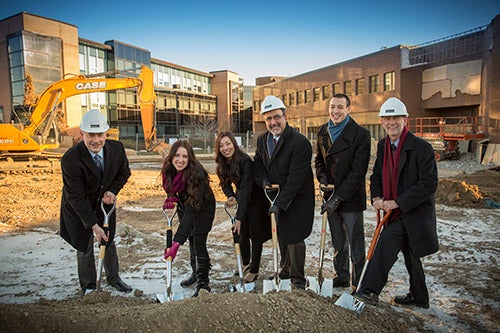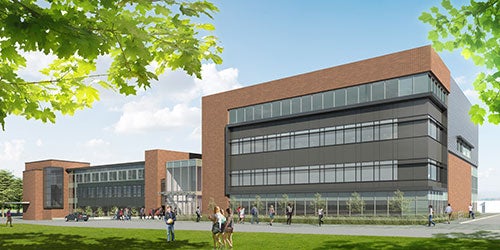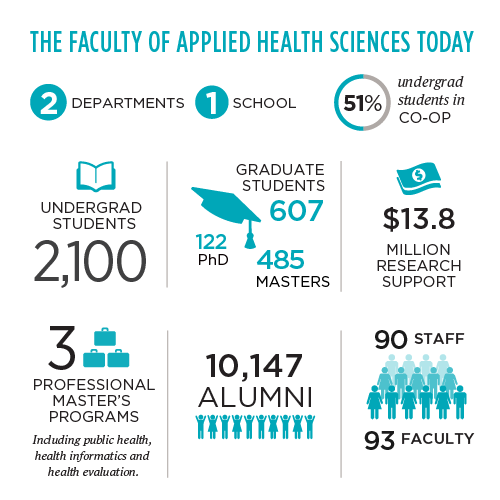
Waterloo breaks ground on new Applied Health Sciences building
56,000-square-foot facility will house state-of-the-art research and teaching space

56,000-square-foot facility will house state-of-the-art research and teaching space
By Christine Bezruki Faculty of Applied Health SciencesA four-storey building that will house state-of-the-art research and teaching space is officially under construction in Waterloo’s Faculty of Applied Health Sciences.
A groundbreaking ceremony, held on December 12, marked the start of a 16-month project to link B.C. Matthews Hall with the Lyle Hallman Institute for Health Promotion.

Left to right - James Rush, interim dean of AHS, Amanda Jones, Mamiko Noguchi, Feridun Hamdullahpur President and Vice-Chancellor, Brendan Leu, Ian Orchard, vice-president academic and provost.
The new 56,000 square-foot-facility is set to include kinesiology research and teaching labs, as well as a 350-seat lecture theatre for classes, public lectures and conferences. The building will house the University’s School of Anatomy, one of only a few anatomy labs outside of medical schools in Ontario. It will also contain a graduate student seminar room, offices and a number of student workspaces.
“Our physical expansion is only now catching up with the academic and research expansion that has occurred over the past several years,” said Professor James Rush, interim dean. “Producing world-class research and providing exceptional training remains a top priority, and our new facilities will help support that.”

Credit: IBI Group Architects and Melloul Blamey Construction
When the Faculty of Applied Health Sciences— originally called the School of Physical and Health Education— first opened its doors in 1966, it employed just five faculty members, operated with 400 square feet of lab space and offered only one-year programs in physical education.
Today, Applied Health Sciences offers a selection of 20 degree programs and specializations spanning three different departments, and is home to approximately 25,000 square feet of lab and research space. More than 2,100 undergraduate students and 620 graduate students call the Faculty home.

Applied Health Sciences’ newest program, a Masters of Health Evaluation, will welcome its first students in the fall of 2015. It is the first professional online program of its kind in Canada.
“Today’s academic landscape is changing. While Waterloo has always been a leader in innovative education models, AHS has embraced this approach and it shows in the range of programs we offer our students,” said Rush.
Far from its humble beginnings, AHS now boasts a faculty complement of 93 professors and the second-highest level of per capita research funding at the university.
“Over the last four decades, AHS has grown significantly in terms of enrolments, programs, people, and research intensity. The new physical spaces will give us the freedom to dream even bigger,” said Rush. “It truly represents a new frontier of learning and scholarship.”
For updates on the expansion visit the Applied Health Sciences Expansion Project.

Read more
Here are the people and events behind some of this year’s most compelling Waterloo stories

Read more
Researchers awarded funding to investigate ecology, climate change, repatriation, health and well-being through cultural and historical lens

Read more
Irfhana Zakir Hussain works to strengthen Waterloo’s capacity to withstand and recover from climate-related health crises
The University of Waterloo acknowledges that much of our work takes place on the traditional territory of the Neutral, Anishinaabeg, and Haudenosaunee peoples. Our main campus is situated on the Haldimand Tract, the land granted to the Six Nations that includes six miles on each side of the Grand River. Our active work toward reconciliation takes place across our campuses through research, learning, teaching, and community building, and is co-ordinated within the Office of Indigenous Relations.